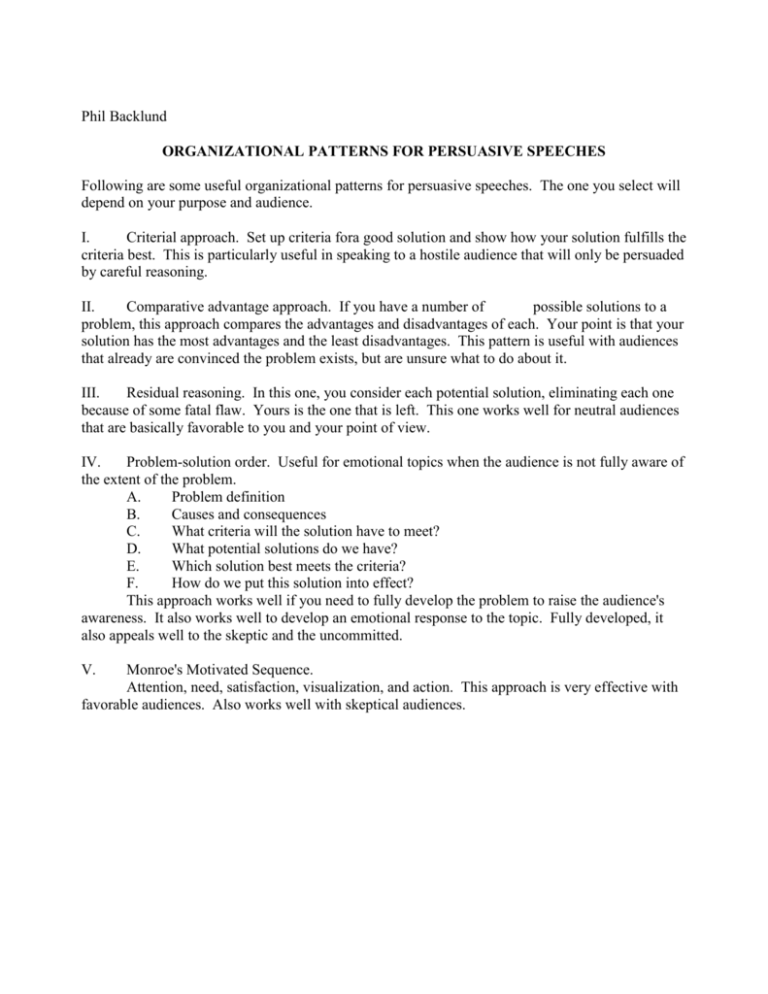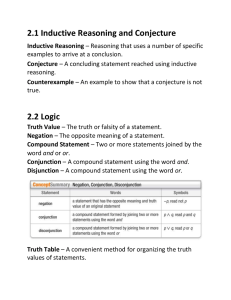Persuasive speaking
advertisement

Phil Backlund ORGANIZATIONAL PATTERNS FOR PERSUASIVE SPEECHES Following are some useful organizational patterns for persuasive speeches. The one you select will depend on your purpose and audience. I. Criterial approach. Set up criteria fora good solution and show how your solution fulfills the criteria best. This is particularly useful in speaking to a hostile audience that will only be persuaded by careful reasoning. II. Comparative advantage approach. If you have a number of possible solutions to a problem, this approach compares the advantages and disadvantages of each. Your point is that your solution has the most advantages and the least disadvantages. This pattern is useful with audiences that already are convinced the problem exists, but are unsure what to do about it. III. Residual reasoning. In this one, you consider each potential solution, eliminating each one because of some fatal flaw. Yours is the one that is left. This one works well for neutral audiences that are basically favorable to you and your point of view. IV. Problem-solution order. Useful for emotional topics when the audience is not fully aware of the extent of the problem. A. Problem definition B. Causes and consequences C. What criteria will the solution have to meet? D. What potential solutions do we have? E. Which solution best meets the criteria? F. How do we put this solution into effect? This approach works well if you need to fully develop the problem to raise the audience's awareness. It also works well to develop an emotional response to the topic. Fully developed, it also appeals well to the skeptic and the uncommitted. V. Monroe's Motivated Sequence. Attention, need, satisfaction, visualization, and action. This approach is very effective with favorable audiences. Also works well with skeptical audiences. Phil Backlund TYPES OF PROOF Persuasive presentations need proof. Basically, there are three types of proof together with forms of support and style that flesh them out. I. Dramatic Proof A. Narrative B. Eye witness C. Anecdote D. Emotional appeals II. Logical Proof A. Cost/rewards B. Cause to effect C. Symptoms D. Deductive and/or inductive reasoning E. Criteria III. Personal Proof, credibility A. Trustworthiness B. Dynamic C. Likability IV. Forms of support that can be used in any of the above areas A. Definitions B. Factual and/or hypothetical examples C. Statistics D. Quotes/testimony V. Forms of style that increase the effectiveness of proof. A. Use active rather than passive verbs B. Use words that appeal to the senses C. Use words that are specific and concrete, rather than abstract and general. D. Short sentences usually work better. E. Use figures of speech where appropriate such as metaphors, similes, alliteration, etc. F. Use repetition of key phrases G. Use parallel phrasing for main points







